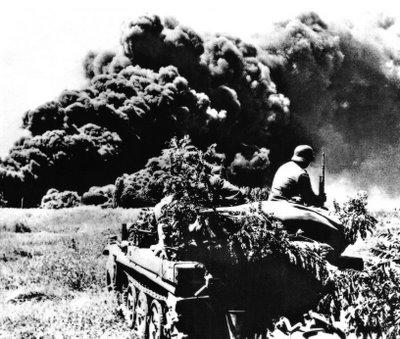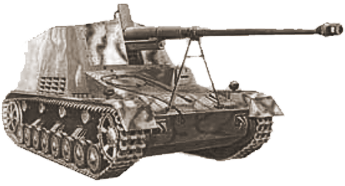The Izyum Salient

In the spring of 1942 Soviet General S. K. Timoshenko led one of the Red Army's several attempts to wrest the initiative from the Germans in this case by launching an offensive from the Izyum salient and designed to destroy Germany's Army Group South and push on to Kiev. The Izyum salient was located in a stretch of flat tank friendly land situated within a larger region featuring great bends in the Dnieper, Don, and Donets Rivers, it was so named because of the city of Izyum's location at the salient's base. The unusually shaped salient was actually a 60 square mile square shaped bulge in German lines left over from where Stalin's January 1942 offensive had finally ran out of steam.
The Red Army concentrated potent offensive striking power in the region including the Bryansk Front, the Southwestern Front and the Southern Front. The Red Army was beginning its transition from the infantry heavy mass assault army of the previous year into a more mobile, mechanized army capable of taking the first steps toward realizing the promise offered by Deep Operations. To that end, Stavka had massed 640,000 men, 1,200 tanks, 13,000 guns, and 926 aircraft in the two Fronts spearheading the assault. Unbeknownst to Timoshenko however, the Germans were beefing up Army Group South in preparation for Operation Blue and facing Timoshenko would be 500,000 men and 600 tanks from the 1st Panzer Army, 6th Army, and 17th Army, all well supported from the air.
That said, Timoshenko's offensive enjoyed considerable initial success after it began at 0630 hours on May 12, 1942. The massive Soviet artillery and aerial bombardment that hit the German positions, followed by massed tank assaults, caused huge sections of the Axis front to vaporize. Timoshenko's 6th Army, reinforced with the 21st and 23rd Tank Corps in reserve to exploit an opening, blew open a 30 mile hole in the southern part of the Axis lines. On the northern sector of the salient, though the offensive was going well, the Germans were holding up a bit better. However, Timoshenko waited far too long to commit his second echelon, the 21st and 23rd Tank Corps, to exploit the gains increasingly coming at greater cost as the German reacted. When he did commit his reserves, their distance from the front meant they bogged down on roads clogged with the assault armies, and heavily damaged by combat.
Meanwhile, Halder and Bock prepared a powerful counterblow designed to wipe out Timoshenko's shock armies. Luftflotte 4 quickly dropped most operations in the Crimea and massed behind the German front near Izyum. Kleist, commanding First Panzer Army, had also taken temporary command of the German 17th Army and two Romanian Corps with his powerful collection of men and machines spearheaded by General Eberhard von Mackensen's III Panzer Corps; comprising the 14th Panzer Division, 60th Motorized Division, 1st Mountain Division, 100th Light Infantry Division, and Romanian 20th Infantry Division. Kleist's reinforced First Panzer Army would team with Friedrich von Paulus' Sixth Army, bearing the brunt of the Soviet offensive, to push deep into the flanks of the Soviet Southwest Front's attack. Striking from its assembly positions south of the Barvenkovo bridgehead Kleist's Panzer Army met with instant success and by May 18th he had crushed Timoshenko's southern wing while Richtofen's Luftflotte 4 ripped apart Soviet command and control centers. Timoshenko and Khrushchev failed to react adequately to the threat generated by the German counter thrust and, even worse, convinced Stalin they had the situation under control even as Vasilevsky desperately attempted to convince Stalin otherwise.
On May 22nd Mackensen's 14th Panzer Division met up with the German Sixth Army's LI Corps advancing south, deep behind the Soviet spearheads. Army Group South had caught two entire Soviet armies, 6th and 57th, two tank corps, 21st and 23rd, a cavalry corps, two independent infantry divisions and a huge bag of Soviet generals in a pocket running only ten miles in length and two miles in breadth. After nearly a full week of constant bombardment from German artillery and aircraft the Soviet army's surrendered on May 28th. The Soviet Fronts involved in the offensive had lost nearly 300,000 men against 20,000 German casualties. The Southwestern Front commander, the commanders of the 6th and 9th Armies and General Bobkin were all dead as were nearly every divisional commander in the Soviet 6th and 9th Armies. In addition the Red Army had lost 1,249 tanks - according to the Germans or 652 tanks -according to the Russians, 2,026 guns and mortars - according to the Germans or 4,924 guns and mortars - according to the Russians, and 540 aircraft in the failed offensive.
By Steven Douglas Mercatante



Post new comment